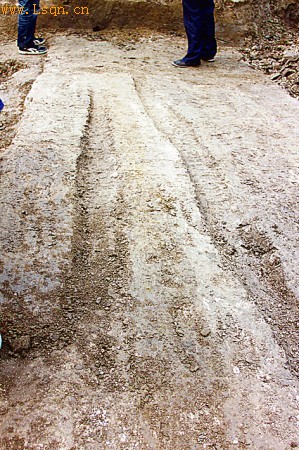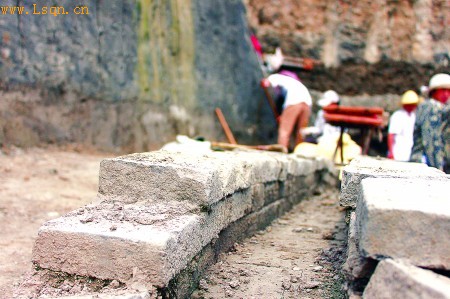
Tang and Song Dynasties reached Daming Lake.

the drains in Tang and Song dynasties are still intact.
the archaeologists were located at the site of the Kaiyuan square in the Hunan side of Daming, and found many relics of the Tang and Song Dynasties, including rutting and water drains. Researchers say that this archaeological discovery is likely to subvert the history of Daming Lake and Ji'nan.
26 afternoon, the reporter came to the archaeological excavation site. In this area with less modern architecture and less impact on excavation, the Archaeological Institute of Ji'nan, after 20 days of excavation, found many relics in the Tang and Song Dynasties, including two layers of pavement, a brick water collection facility and a number of big water trenches in the north and the south. "This proves that during the Tang and Song Dynasties, the springs in southern Ji'nan were very abundant," explains Dr. Yan Yan Feng, a Ji'nan Archaeology Institute who was involved in the excavation at
according to the introduction, the "Tang Dynasty road" is about 2.1 meters wide, with a residual length of more than ten meters and 6.2 meters away from the present surface. Archaeologists believe that the road has been formed in the Tang Dynasty, and has continued to use and fold up to the Song Dynasty. There are two long rutting tracks in the middle of the road [color=#755201]. The plane of the road is basically the same as the opening plane of the ditches, and the directions are all north-south. It can be concluded that the road is the main road beside the water. [/color]
archaeological excavations found that the depth of the deep black silt layer above the Tang Dynasty is about 3 meters in thickness, about 2.2 meters from the present surface, and the time span is from the Song Dynasty to the Republic of China. A large number of aquatic animals, such as mussels and shells, are left in the silt, and a small amount of grey tiles and porcelain pieces and several bean handles and bean plates are unearthed. In addition, traces of ash pit, ditch and road were found in this cultural layer, and pottery pots and copper coins of Kaiyuan Tong Bao were found.
archaeologists believe that a large amount of silt deposited on the ground in the Song Dynasty has been piling up from the Song Dynasty to the Republic of China for a long time. This silt layer may be related to the flood in the local area during the early formation, and the bottom of the silt layer found the artifacts of the Han Dynasty and earlier period. "It shows that in the Song Dynasty, when the flood submerged the ground in a short time, it became the surface of the water."
Li Ming, director of Ji'nan Institute of archaeology, believes that this archaeological discovery is of great significance to the study of the formation history of Daming Lake and Ji'nan city. "Who lived in the six meters underground at Daming Lake? How is Daming Lake formed? When did it come into being? How did the regional change in Ji'nan be affected by springs and Daming Lake marshes? How is the water level changed? There may be subversive answers to these questions. "